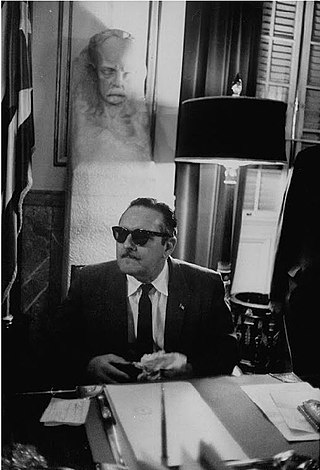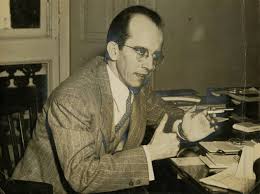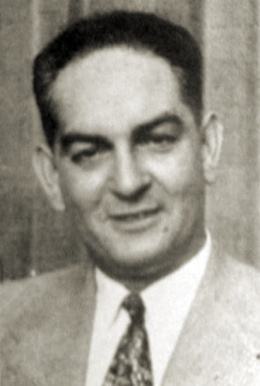
Fulgencio Batista y Zaldívar was a Cuban military officer and politician who served as the elected president of Cuba from 1940 to 1944 and as a military dictator from 1952 until his overthrow in the Cuban Revolution in 1958.

The Cuban Revolution was the military and political effort to overthrow Fulgencio Batista's dictatorship which reigned as the government of Cuba between 1952 and 1959. It began after the 1952 Cuban coup d'état which saw former president and military general, Fulgencio Batista topple the nascent Cuban democracy and consolidate power. Among those opposing the coup was Fidel Castro, then a novice attorney who attempted to contest the coup through Cuba's judiciary. Once these efforts proved fruitless, Fidel Castro and his brother Raúl lead an armed attack on the Cuban military's Moncada Barracks on July 26, 1953. Following the attack's failure, Fidel Castro and his co-conspirators were arrested and formed the 26th of July Movement (M-26-7) in detention. At his trial, Fidel Castro launched into a two hour speech that won him national fame as he laid out his grievances against the Batista dictatorship. In an attempt to win public approval, Batista granted amnesty to the surviving Moncada Barracks attackers and the Castros fled into exile. During their exile, the Castros consolidated their strategy in Mexico and subsequently reentered Cuba in 1956, accompanied by Che Guevara, whom they had encountered during their time in Mexico.

The Moncada Barracks were military barracks in Santiago de Cuba, Cuba named after General Guillermo Moncada, a hero of the Cuban War of Independence. On 26 July 1953, the barracks was the site of an armed attack by a small group of revolutionaries led by Fidel Castro. That day a simultaneous attack was carried out on the Carlos M. de Cespedes Barracks in Bayamo directed by Raúl Martínez Ararás by order of Castro. The attack failed and the surviving revolutionaries were imprisoned. This armed attack is widely accepted as the beginning of the Cuban Revolution. The date on which the attack took place, 26 July, was adopted by Castro as the name for his revolutionary movement, Movimiento 26 Julio, which eventually toppled the dictatorship of Fulgencio Batista on 1 January 1959.

Manuel Urrutia Lleó was a liberal Cuban lawyer and politician. He campaigned against the Gerardo Machado government and the dictatorial second presidency of Fulgencio Batista during the 1950s, before serving as president in the revolutionary government of 1959. Urrutia resigned his position after only seven months, owing to a series of disputes with revolutionary leader Fidel Castro, and emigrated to the United States shortly afterward.
Manuel Piñeiro Losada, also known as Commander Barbarroja was a Cuban political and military figure, a leader of the Cuban Revolution, and, between 1961 and 1964, the first head of the Dirección General de Inteligencia of Cuba. Under Piñeiro, the DGI supported armed struggles in Latin America, helping radical leftist guerrilla groups in the region. Between 1964 and 1968, Piñeiro acted as the Deputy Minister of the Interior of Cuba, during this time he was in charge of the state security apparatus. A Soviet reorganization of the DGI forced Piñeiro out of his position, and he was placed in charge of the DGI's Latin American affairs division.

Fidel is a 2002 mini-series by David Attwood that describes the Cuban revolution and political career of Fidel Castro. The total duration of the film is 200 minutes, but the video-version is shorter. Gael García Bernal would later reprise his role as Che Guevara in the film The Motorcycle Diaries.

Hotel Tryp Habana Libre is one of the larger hotels in Cuba, situated in Vedado, Havana. The hotel has 572 rooms in a 25-floor tower at Calle 23 and Calle L. Opened in 1958 as the Habana Hilton, the hotel famously served as the residence of Fidel Castro and other revolutionaries throughout 1959, after their capture of Havana.

Plaza de la Revolución, "Revolution Square", is a municipality and a square in Havana, Cuba.

Carlos Hevia y de los Reyes-Gavilan was the interim President of Cuba, serving for less than three days. During the third week of 1934, Hevia was President from 5:00 p.m. on Monday, January 15, until 1:20 a.m. on Thursday, January 18. Cuban junta leader Fulgencio Batista had obtained the resignation of Hevia's predecessor, Ramón Grau. The choice of Hevia was unpopular with the military, and by Wednesday, the new President was asked to resign. He was replaced by Manuel Márquez Sterling.

Vilma Lucila Espín Guillois was a Cuban revolutionary, feminist, and chemical engineer. She helped supply and organize the 26th of July Movement as an underground spy, and took an active role in many branches of the Cuban government from the conclusion of the revolution to her death. Espín helped found the Federation of Cuban Women and promoted equal rights for Cuban women in all spheres of life.
Mario Chanes de Armas was a former Cuban revolutionary and ally of Fidel Castro. He was a veteran of the attack on the Moncada barracks in July 1953 and served time in Batista's New Model Prison on the Isle of Pines with fellow revolutionary Fidel Castro. After Castro's rise to power, he was labeled an enemy of the regime and imprisoned for almost 30 years.

Dr. Carlos Márquez Sterling y Guiral was a Cuban lawyer, writer, politician and diplomat.

Felipe Pazos Roque was a Cuban economist who initially supported the Cuban Revolution of Fidel Castro, but became disillusioned with the increasingly radical nature of the revolutionary government. Born in Havana, Pazos earned a doctorate from the University of Havana in 1938. He was a member of the Cuban delegation to the 1944 Bretton Woods conference. In 1946, he joined the staff of the fledgling International Monetary Fund that had been established at the Bretton Woods conference. He worked there for three years before returning to Cuba in 1950 to head the newly established National Bank of Cuba for two years at the behest of Cuban President Carlos Prío Socarrás.

Aureliano Sánchez Arango was a Cuban lawyer, politician and university professor.

Coliseo de la Ciudad Deportiva is an indoor sporting arena located in Havana, Cuba. Built in 1957, the Coliseum is one of the most important works of Cuban Civil Engineering. It is located at the intersection of Boyeros and Vía Blanca avenues in the Cerro Municipality. The capacity of the arena is for 15,000 spectators.
The Cuban Revolution was not only fought by armed rebels on the battlefield but also through the propaganda campaigns designed and orchestrated by Fidel Castro and his rebel comrades. Propaganda in Cuba during the revolution included Castro's use of personal interviews with journalists, radio broadcasts and publicity seeking operations that contributed significantly to the victory of the rebels over Fulgencio Batista's government and provided insight into the successful propaganda campaign established by Castro after gaining power. The limited yet successful revolutionary propaganda apparatus transitioned into what Castro has called "one of the most potent weapons in his foreign policy arsenal." Today the Cuban government maintains an intricate propaganda machine that includes a global news agency, magazines, newspapers, broadcasting facilities, publishing hoes , front groups, and other miscellaneous organizations that all stem from the modest beginnings of Castro's revolutionary propaganda machine.

The Tren Blindado is a national monument, memorial park, and museum of the Cuban Revolution, located in the city of Santa Clara, Cuba. It was created by the Cuban sculptor José Delarra on the site of and in memory of the capture of an armoured train on 29 December 1958, during the Battle of Santa Clara.
The early life of Cuban dictator and politician Fidel Castro spans the first 26 years of his life, from 1926 to 1952. Born in Birán, Oriente Province, Castro was the illegitimate son of Ángel Castro y Argiz, a wealthy farmer and landowner, and his mistress Lina Ruz González. First educated by a tutor in Santiago de Cuba, Fidel Castro then attended two boarding schools before being sent to El Colegio de Belén, a school run by Jesuits in Havana. In 1945 he began studying law at the University of Havana, where he first became politically conscious, becoming a staunch anti-imperialist and critic of United States involvement in the Caribbean. Involved in student politics, he was affiliated to Eduardo Chibás and his Partido Ortodoxo, achieving publicity as a vocal critic of the pro-U.S. administration of President Ramón Grau and his Partido Auténtico.
Aníbal Escalante Dellundé was a Cuban communist and political organizer. An early leader within the Popular Socialist Party (PSP), he briefly held national office in Cuba following the Cuban revolution but was purged due, in part, to his "old-line" Marxist orthodoxy. He was later imprisoned over allegations he was plotting with the Soviet Union to orchestrate the overthrow of the Fidel Castro-led Cuban government.

The 1957 Havana Presidential Palace attack was a failed assassination attempt on the life of President Fulgencio Batista at the Presidential Palace in Havana, Cuba. The attack began at around 3:30 pm on March 13, 1957, carried out by Menelao Mora, a group of members of the Partido Auténtico, and the student opposition group Directorio Revolucionario 13 de Marzo, but was unsuccessful in its goal of killing Batista. According to one of the group's founding members, Faure Chomón, they were following the golpe arriba strategy and sought to overthrow the government by killing Batista.















